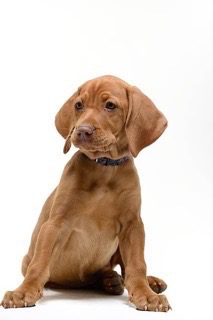
“The Vizsla is a loyal and dedicated breed of dog that originated from Hungary and dates back to the 10th Century. This breed was a versatile hunting and family dog primarily used to hunt birds and small game, as well as guard the home. They have a short coat that is usually golden-rust in color. The coat is smooth and doesn’t shed too much. The Vizsla’s body is compact, muscular and well-proportioned, with a deep chest and legs that are strongly muscled. They stand on average between 21 to 24 inches and can weigh between 40 to 65 pounds. Uniquely, the Vizsla has a short muzzle and long drooping ears. The nose can be either brown or black but the eyes are brown. This breed is known for its eyes that are highly expressive. Brown, sand and yellow are the most common colors for the Vizsla, however there are other combinations as well. The Vizsla was created with a combination of Hungarian breeds, with some ancestry being traced to the extinct strain of the Transylvanian Hound and the ancient Turkish Yellow Pointer. The Vizsla is unique in that it is a high energy breed combined with the abilities of a highly intelligent work. Combined with a friendly, loyal and affectionate nature, the Vizsla makes an excellent companion for all types of family. They are not aggressive and are very well suited for families with children.
Vizslas are energetic, friendly, and obedient dogs that are also highly intelligent. They are gentle and loving towards people and are known for their patience and loyalty. Vizslas are incredibly playful and are great with children and other household pets. Early training and socialization are key in teaching this breed their boundaries and manners. Vizslas are quite active and need plenty of daily exercise to stay healthy and happy. They should get 1-2 hours of exercise daily, such as walks, runs, or playtime. This breed is adaptable and can be easily kept indoors but they can also be quite noisy. Suitable activities for a Vizsla include daily walks, runs, hikes, and playtime with their owners. These dogs form strong bonds with their owners and can be the ideal companions for an active, involved family.
Vizsla’s are a medium-sized breed of dog with a smaller, athletic build and an energetic disposition. They require an active lifestyle, plenty of physical activity, and an appropriate, balanced diet. Vizsla’s need a diet of high-quality dog food specifically designed for their age, size, and activity level. Other nutritional requirements include a good source of proteins, healthy fats, essential fatty acids, and high-fiber carbohydrates. They need plenty of water each day to stay hydrated and keep their digestive system functioning properly. It is important for Vizsla owners to monitor their dog’s food intake to ensure they are getting all the required nutrients and minerals for a healthy life. Feeding them too many treats can lead to obesity and other health issues. Responsible ownership is key to keeping a dog healthy. Adopting a Vizsla means being familiar with its dietary and exercise requirements. For more information about this breed, its nutritional needs, and the best foods to offer, check out Way Canina. We believe that providing your Vizsla with the right foods, exercise opportunities, and medical care will help keep him or her happy and healthy for years to come.
Some health issues to look out for include hip dysplasia, eye disease, epilepsy, and bloat. Additionally, genetic predispositions correlate with health issues such as canine lymphoma, hypothyroidism, and breast cancer. Regular veterinary check-ups and vaccinations are essential to maintain a healthy dog.
The Vizsla is a highly energetic, loyal breed of dog that typically lives 12-14 years. Being an active breed, regular exercise is essential for its physical and mental development. Furthermore, preventive care must include brushing, bathing, and cleaning the ears regularly. Proper diet and exercise will help ensure your Vizsla has a longer life expectancy and can live to their full potential.
Are you a proud owner of a Vizsla or are you thinking of adding one to your family? Before taking the plunge, be sure to consider the responsibilities, pros and cons of owning a Vizsla. For additional information and a better comparison between breeds check out our blog posts and articles on Way Canina. Here, you will find plenty of information about dogs’ lifestyle and wellbeing.